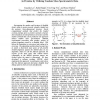Free Online Productivity Tools
i2Speak
i2Symbol
i2OCR
iTex2Img
iWeb2Print
iWeb2Shot
i2Type
iPdf2Split
iPdf2Merge
i2Bopomofo
i2Arabic
i2Style
i2Image
i2PDF
iLatex2Rtf
Sci2ools
CBMS
2006
IEEE
2006
IEEE
MS2DB: An Algorithmic Approach to Determine Disulfide Linkage Patterns
Determining the number and location of disulfide bonds within a protein provide valuable insight into the protein’s three-dimensional structure. Purely computational methods that predict the bonded cysteine pairings given a protein’s primary structure have limitations in both prediction correctness and the number of bonds that can be predicted. Our approach utilizes tandem mass spectrometric (MS/MS) experimental procedures that produce spectra of protein fragments joined by a disulfide bond. This allows the limitations in correctness and scaling to be overcome. The algorithmic problem then becomes how to match a theoretical mass space of all possible bonded fragments against the MS/MS data. In our algorithm, which we call the Indexed approach, the regions of the mass space that contain masses comparable to the MS/MS spectrum masses are located before the match is determined. We have developed a software package, MS2DB, which implements this approach. A performance study shows that...
CBMS 2006 | Disulfide Bond | Medical Imaging | Protein’s Primary Structure | Protein’s Three-dimensional Structure |
| Added | 10 Jun 2010 |
| Updated | 10 Jun 2010 |
| Type | Conference |
| Year | 2006 |
| Where | CBMS |
| Authors | Timothy Lee, Rahul Singh, Ten-Yang Yen, Bruce Macher |
Comments (0)

